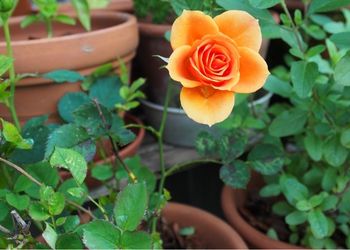Mini roses not blooming is an issue I’ve had myself, and others ask me about. Truth is roses are not as hard to grow as most other plants. But they do have their occasional issues. So here I’m going through some of the issues you’re likely to face to answer “mini roses not blooming”.
Let’s start with a brief answer to get you started, then we’ll get into more details.
Common reasons why your mini roses are not blooming comes down to:
- Lack of sunlight – roses need 6-8 hours of full and direct sunlight
- Blind shoots – Stems without buds
- Watering Issues – Too much or too little
- Over or under fertilizing
- Inappropriate soil pH level – Roses ideally need 6.5 – 7.0
- Too much or too little pruning
- Pest damage
- Improper winterizing
So that’s the overview, let’s look at these in a little more depth and what to do to fix a mini rose not flowering.
Mini roses not blooming
Growing conditions that are well below ideal are the main reason for your mini rose not flowering as it should. It’s perhaps also the obvious reason why many flowers don’t bloom.
However, if we’re going to get specific about “why is my mini rose not blooming”, they essentially come down to a few crucial factors I alluded to in the short answer paragraph.
Now let’s have a closer look into each of these causes and what control mechanisms and solutions we can use to tackle them.
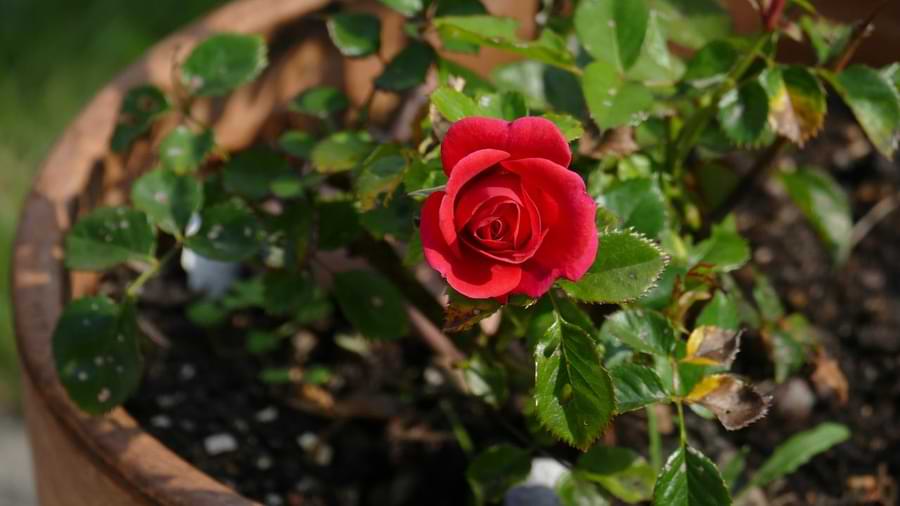
Lack of Sunlight
In the order of factors that distract mini roses from blooming, lack of sunlight certainly takes the lead.
For mini roses to grow and bloom fully to their potential they need sufficient sunlight.
Just like with the other types of roses, mini roses can rarely get too much sunlight, and it’s for this reason some rose experts strongly believe mini roses are not meant to be grown as indoor plants.
Growing mini roses indoors – and not doing it right – can deprive them of the sufficient sunlight they need, which in turn does not allow them to grow healthy or of offer up their fullest blooms.
Solution
On average your mini roses should receive at least 6-8 hours of full and direct sunlight.
It’s also recommended to provide them with morning sunlight, as this is less intense in terms of heat.
If you have no option but to grow mini roses indoors, make sure you are keeping them in a place where they can get proper access to sunlight.
Try to turn the pots around each week, so the plant gets sunlight evenly.
Sunlight is also essential to give your mini roses the best disease resistance capacity, which helps in producing the fullest bloom-packed bush.
Check out our guide to mini roses and sunlight for more information regarding this area of concern and to get this right for them.
Blind shoots
Mini roses, just like other rose varieties from time to time, push out canes that are called “Blind shoots”.
What are blind shoots on roses?
On roses, blind shoots are a result of flower buds failing to develop due to the abortion of the flower’s organs. Although blind shoots may be deceiving as they look like healthy rose canes, they will not form buds nor will they bloom. So keep a look out for these phantom canes.
Even with blind shoots, your plant may look happy and healthy with no obvious signs of damage or weakening stems.
If you see all the shoots have a bud forming but one or more don’t show even a hint of a bud, then there’s a good chance it’s a blind shoot.
While one or two blind shoots should not be alarming, the more blind shoots that form means your plant will weaken and eventually stop blooming …or fail to have anything like as many blooms as usual. It will simply look sparse.
If that happens, then check out my article on how to revive a mini rose.
Solution
Unfortunately, there is no evidence backed up by a study or any research that points out the reasons for blind shoots in roses, including miniature roses …or pretty much any plant for that matter.
But experts speculate it could be caused mainly by temperature fluctuations between warm and cool, and dry and wet weather.
To address blind shoots:
- Cut the blind shoot back by half up to a strong bud to stimulate further growth. This can help the plant prepare itself for healthy blooms the next season.
- Remove a proportion of older wood to encourage new growth and better blooms. The ideal time to do this is during annual pruning in the winter season.
- Improve the growing and blooming conditions of your miniature rose plant by feeding with a proprietary rose fertilizer and mulching.
- Make sure the rose plant is kept in a sunny open location with direct access to sunlight, regardless of whether they are grown indoors or outdoors.

Watering issues
Both over and underwatering your miniature rose plant stresses them. And when a plant is stressed because of either lack of, or too much moisture, this brings about the “mini rose not blooming” issue with no flowers being produced.
Overwatering can lead to root rot, and then eventually take a toll on the health of the plant …which may affect a healthy bloom.
On the other hand underwatering, especially during intense times of summer can deprive the rose of required moisture.
🌹 Under-watered rose leaves turn yellow but remain dry.
🌹 Overwatered rose leaves on the other hand turn yellow but appear droopy.
You can see below my roses are showing yellow patches and even a few scorch marks following a particularly hot and dry period.
But they’re not drooping, so I’ll give them more frequent watering over the next week or so and that should solve the problem. Mini roses act in much the same way.

Solution
First, you need to determine the temperature or weather conditions of the place you live in and then plan your watering schedule accordingly.
While watering once a day is usually recommended, in winter you can cut this down to twice a week or less. Here’s more on when to water roses.
And if you live in a relatively temperate area, then in addition to watering daily, you may also have to mist the plants in the afternoon to keep the plant moist and hydrated. As much of the water you give to the plant in the morning evaporates leaving the plant thirsty.
You can also check if the plant is over or underwatered by poking your finger into the soil to check moisture. If the soil is dry it means the plant is under-watered. If the soil is too moist, it could be a result of overwatering.
Usually overwatering occurs due to soil that’s poorly draining.
If you’re growing your mini roses in plants or containers, make sure they have holes to drain water properly.
And if you’re growing outdoors underground, consider their draining capabilities. If you feel the soil has poor drainage, add some compost to it to increase its draining properties.
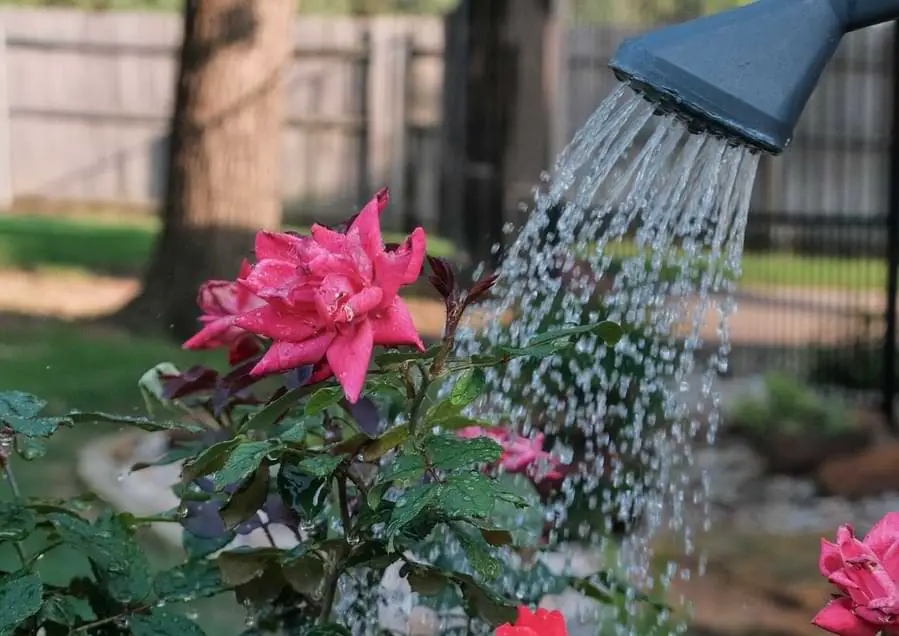
Over or under fertilizing and wrong pH level
Fertilizers are an element needed for mini roses to thrive to their optimum potential.
While they are also heavy fertilizer feeders, too much or the wrong kind of fertilizer lets your plant produce foliage at the expense of blooms.
It’s tempting for us to think that over-fertilizing can lead to bigger, better, and fuller blooms, but sadly too much fertilizer in worse cases can lead to your mini rose not flowering, and plants that don’t produce blooms at all.
Alongside fertilizing issues, poor soil that is either too rocky or too sandy can also restrict the blooming capacity of your miniature roses.
Usually, for miniature roses, the soil should have a pH level of 6.5 – 7.0. Anything below or above this makes the plant less likely to absorb the essential nutrients and encourages blooms.
There are some tolerances outside this range, but abnormal pH can cause veins to yellow first, followed by the leaves.
Here’s more about the best soil for miniature roses.
Solution
Firstly check if your soil is at an appropriate pH level.
For this there are plenty of soil testing tools on amazon you can easily buy at affordable rates. This soil tester will also help you easily determine what nutrients your soil lacks.
Usually, mini roses require a good amount of nitrogen to help plants grow, and form buds, which then turn into blooms. If they go through a poor growing stage as a result of a lack of nitrogen, the plant won’t give out blooms.
Again there are plenty of fertilizers made just for roses available on Amazon, some are also specific to the type of mini rose or variety you’re growing.
Once your soil test is done, choose an appropriate fertilizer and follow the directions on the label.
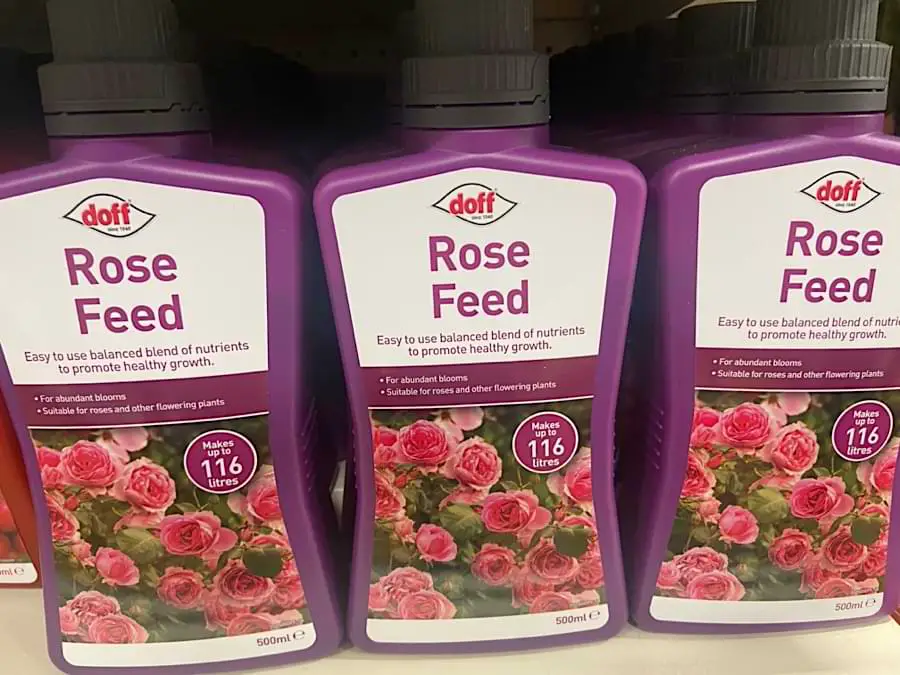
Other causes of your mini rose not flowering
If you’ve exhausted all the above issues and think you’ve sufficiently corrected them. Then there may be a few other avenues you can explore to solve the problem.
So apart from the above factors, improper winterizing, too much or too little pruning, and excessive pest damage can also be minor reasons why your mini roses don’t bloom.
Winterizing and pruning only become a concern during winter. Check out our article on “how to make mini roses survive winter” for more information on this area.
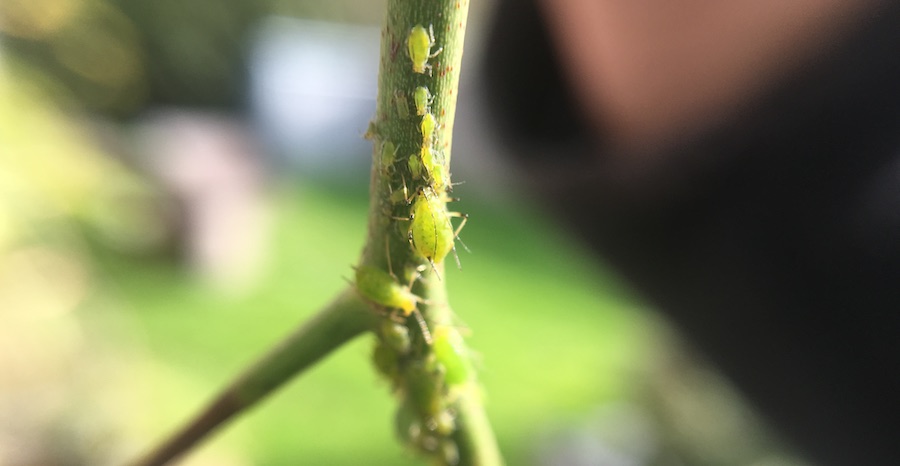
Regarding pest damage, very often this can be prevented by following the control mechanisms given above, as proper light, fertilizing, moisture, along with good soil conditions can increase the defense capacity of your rose plant to fight off pests.
Another way to avoid pest damage is by companion planting. Check out my list of rose companion plants for some great ideas of what to plant with your roses.
Mini roses not blooming ~ More roses help 🌹
I hope this has given you some options to look at to solve your mini roses not blooming issue.
Be sure to check out my other articles, and also take a look at my tools and resources page to help grow your roses!

Hi, I’m Michael. My passion for roses was sparked a few years ago after visiting a dedicated community rose garden. So Rosehow.com represents my take, my learnings, and my help for anyone looking to grow, be proud of, and harvest roses.

